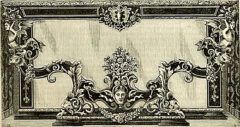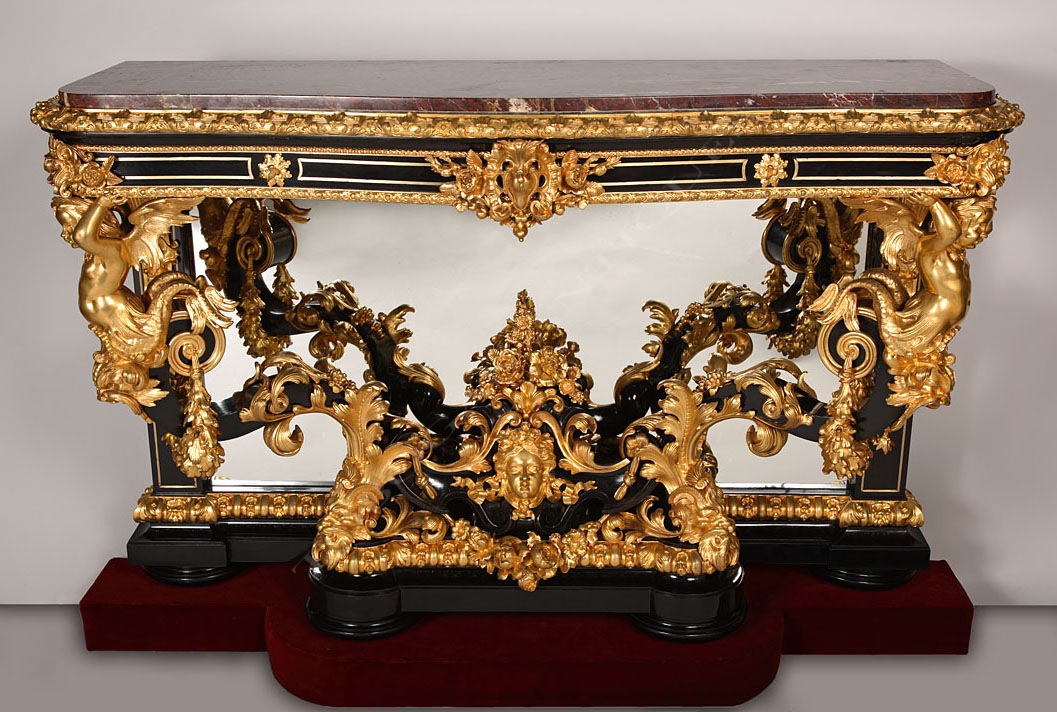ref. 699
M. Liénard
Sculptor-Designer
(1810-1870)
G. Grohé
Cabinet-maker
(1808-1885)
Exceptional console
Signed Grohé à Paris
France
Height : 103 cm (40 1/2 in.) ; Length : 150 cm (59 in.) ; Depth : 50 cm (19 2/3 in.)
 Awarded a Gold Medal at the Industrial Products Exhibition of 1844
Awarded a Gold Medal at the Industrial Products Exhibition of 1844
(Reproduced in Musée des Familles, Lectures du Soir, t. XI, juillet 1844, p° 317)
Rare Napoleon III ebony console ornamented with gilt bronze mounts and underlined by a copper thread. Topped with red « griotte » marble. Frieze ornamented with acorn and foliage motifs, centred by a cartouche forming a heart. Legs ornamented with triton-putti and scrolling foliage. Center decorated with ribbons, female mask and naturalistic bouquets. Base ornamented with a twist with oves, acanthus leaves and flowered heads motifs. Mirror backplate. Resting on flat round feet.
Biography
Michel Liénard (1810-1870) worked as a designer and a sculptor. He regularly worked with Guillaume Grohé from 1839 until about 1855. Many of his sketches, now preserved at the French National Library as well as at the Paris Decorative arts Library, allow us to link this console to some other works executed by Liénard and Grohé (Second Album Liénard, dessin CD 4132-126, et Collection Maciet, vol. 344,6, Bibliothèque des Arts Décoratifs, Paris). Liénard worked also for the silversmith François-Désiré Froment-Meurice (1802-1855) and the famous organ maker Aristide Cavaillé-Coll (1811-1899). As a talented designer and sculpteur, Liénard was awarded the Legion of Honor in 1851.
Guillaume Grohé (1808-1885) born in the Grand Duchy of Hesse-Darmstadt came to France about 1827 and settled in Paris. With his brother Jean-Michel, he led in Paris at 30 rue de Varennes the family business “Grohé Frères”, offering furniture and art objects and presented successfully works at the Industrial Products Exhibition of 1834, which earned him an honorable mention. His success was as rapid as considerable. He won a silver medal in 1839 and a gold medal at the Industrial Products Exhibition of 1844. He was awarded the Legion of Honor in 1849 and was later promoted to the rank of officer. In 1861, his brother retired from business, leaving Guillaume alone at the head of the company. With no successor, the company ceased its activity in 1884. Become in recent years one of the leading cabinetmakers of his time, Guillaume Grohé was naturally appointed Supplier of royal and imperial houses: for King Louis XVIII (Louis XIV Console, National Exhibition of 1844; Renaissance style ebony cabinet, 1844), for King Louis-Philippe (Rosewood Commode-secretary, 1839, now in the Louvre museum), for Emperor Napoleon III (Mahogany dining-room furniture at Saint-Cloud Palace, 1855; many mahogany furniture in the Compiègne and Fontainebleau palaces, 1859), and after 1862 for Queen Victoria. Specialized in the making of furniture style, the Duke of Aumale commissioned him to furnish Chantilly Castle, and Mrs. Pelouze, Chenonceaux Castle. Grohé participated brilliantly in the Universal Exhibitions and was there several times a member of the jury. According to the report of the jury of the 1878 Paris Universal Exhibition, Grohé is described as “the undisputed master of the modern cabinet-making, was awarded all forms of praise, as he won all series of rewards.” Maxime Boucheron finally quoted in a Figaro newspaper’s report in 1884 that “Grohé was a truly great master of the art of the nineteenth century woodwork. A career spanning more than fifty years has filled our museums and national palaces with incomparable masterpieces. He assured the preponderance of French taste in furnishing luxury.”
Works to be linked
This console, very illustrative of Second Empire style, can be related to a large ebony and rosewood armoire executed by G. Grohé for the “Salon des Guise” in Chantilly castle (Condé museum, Chantilly).
Bibliography
Musée des Familles, Lectures du Soir, t. XI, juillet 1844, p° 317
Collection Maciet, vol. 344,6, Bibliothèque des Arts Décoratifs, Paris.
Deuxième Album Liénard, dessin CD 4132-126, Bibliothèque des Arts Décoratifs, Paris.
L’Ameublement moderne par MM. Prignot,Liénard, Coignet et plusieurs autres artistes spéciaux, 2 vol.,Charles Claesen, Paris, 1876.
P. Liénard, A. Doussamy, Portefeuille de Liénard : motifs inédits applicables aux arts industriels et somptuaires choisis et mis en ordre par MM. Liénard et Doussamy, sculpteurs, Charles Cklaesen, Paris, s.d.
Les ornemanistes du XIXe siècle. Compositions d’ornements par Feuchère, Liénard, etc., Ducher et Cie, Paris, s.d.
M. Liénard, Specimens de la Décoration et de l’Ornementation au XIXe siècle, 3 vol., Charles Claesen, Liège, 1866.
D. Alcouffe et alii, « Un âge d’or des Arts Décoratifs », Grand-Palais, Paris, 1991.
B. Liénard, Motifs ornementaux : motifs et décors du XIXe siècle, Auxerre, H. Vial, 2003.
Contact us
Tobogan Newsletter
If you want to be up-to-date with our new acquirings you can sign up to our newsletter.

